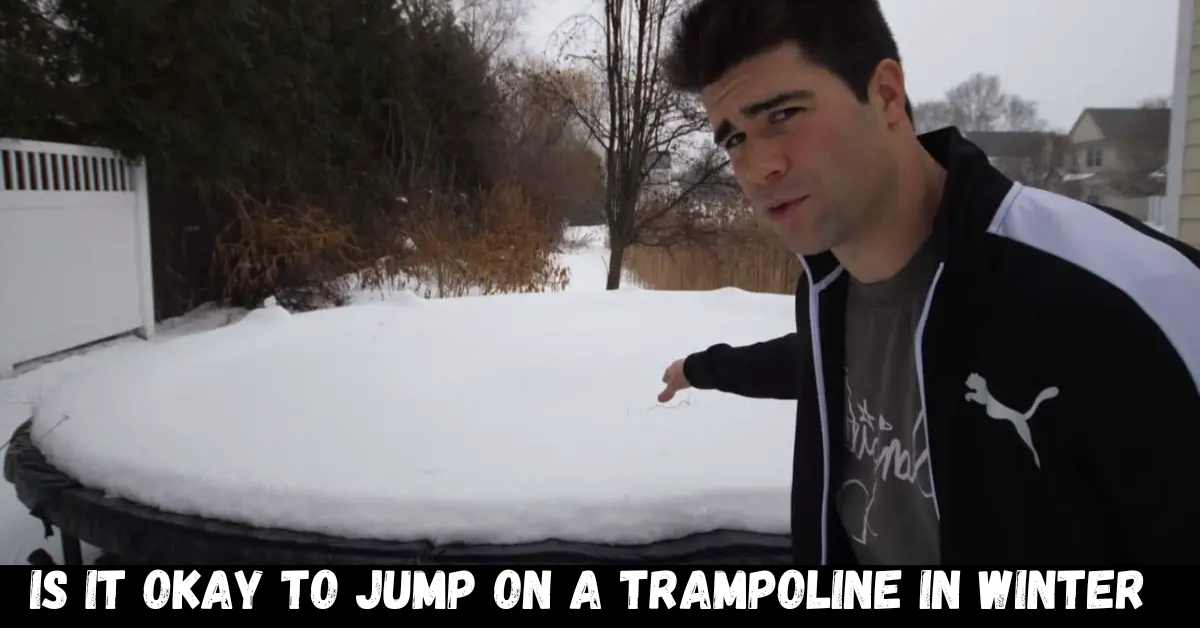Trampolines are a popular recreational activity that provides exhilarating fun and physical exercise. However, when it comes to jumping on a trampoline during the winter months, the question arises: is it okay to engage in this activity when temperatures drop, and snow covers the ground?
This article explores the considerations surrounding trampoline use in winter and provides insights into the safety and practicality of jumping on a trampoline during this season.
Jumping on a trampoline during winter presents unique challenges and potential risks that differ from other times of the year.
Factors such as safety concerns related to icy or snowy conditions, the impact of cold temperatures on both users and the trampoline itself, and the availability of alternatives or precautions must be carefully evaluated.
By examining these considerations, individuals can decide whether it is appropriate and safe to engage in trampoline activities during the winter season.
Is it okay to jump on a trampoline in winter: Jumping on a trampoline in winter requires careful consideration. Safety concerns such as icy conditions and potential trampoline damage should be addressed for a safe and enjoyable experience.
Is it okay to jump on a trampoline in winter?

Jumping on a trampoline in winter can be a topic of debate, as it involves certain considerations and potential risks. While using a trampoline during this season is not inherently wrong, several factors must be considered to ensure safety and enjoyment.
Considerations for Jumping on a Trampoline in Winter
Trampolines provide endless fun and entertainment for people of all ages. However, when it comes to using a trampoline during the winter months, there are some important safety considerations to keep in mind.
Cold weather can introduce potential hazards and risks that may affect both the trampoline and the individuals using it. This article will discuss the safety concerns associated with trampoline use in cold weather and the potential effects of winter conditions on the trampoline’s structure and materials.
Safety Concerns:
Jumping on a trampoline in winter poses unique safety challenges compared to using one in milder weather. Here are some potential hazards associated with trampoline use in cold weather:
Risks of Slips, Falls, and Injuries:
One of the primary concerns during winter is the presence of icy or snowy conditions. Ice and snow on the trampoline surface can create slippery conditions, increasing the likelihood of slips and falls.
These falls can result in injuries such as sprains, fractures, or even head trauma. Therefore, it is crucial to ensure that the trampoline surface is free from ice and snow before using it.
Impact on the Trampoline:
The extreme temperatures of winter can have adverse effects on the trampoline itself. Cold temperatures can cause the materials, especially the mat and springs, to become stiff and brittle.
This can reduce the trampoline’s elasticity and increase the risk of damage or breakage during use. Additionally, freezing temperatures can affect the frame’s structural integrity, potentially leading to weakened joints or even collapse.
Effects of Cold Temperatures on the Trampoline’s Structure and Materials:
Cold weather can have several effects on the structure and materials of a trampoline. Understanding these effects is essential for maintaining the longevity and safety of the equipment. Some potential impacts include:
Stiffness and Brittle Materials:
Low temperatures can make the trampoline mat, springs, and other components stiff and brittle. This stiffness reduces the trampoline’s bounce and increases the risk of damage when subjected to excessive force.
It is crucial to regularly inspect the trampoline for signs of wear and tear, particularly during winter, to identify any weakened or damaged components.
Decreased Elasticity:
Cold temperatures can reduce the elasticity of the trampoline’s mat and springs. A less elastic surface may not absorb impacts as effectively, potentially transmitting higher forces to the user’s body. This can increase the risk of injuries, especially if improper landing techniques are used.
Potential Damage from Freezing Temperatures or Heavy Snow Loads:
Freezing temperatures and heavy snow loads can significantly threaten the trampoline’s structure. When snow accumulates on the mat or the frame, the excess weight can strain the trampoline’s components and potentially cause them to bend or break.
Similarly, freezing temperatures can weaken the joints and connections, compromising the overall stability of the trampoline.
It is essential to take appropriate measures to mitigate the potential damage caused by freezing temperatures or heavy snow loads. Clearing snow from the trampoline regularly and ensuring proper drainage can prevent excessive snow accumulation.
Also, storing the trampoline in a protected area or using a weatherproof cover during winter can help preserve its structural integrity.
Benefits of Jumping on a Trampoline in Winter
When winter arrives, and the temperatures drop, staying indoors and hibernating until spring can be tempting. However, staying active during winter is crucial for maintaining a healthy lifestyle.
Jumping on a trampoline in winter provides a fun and exhilarating experience and offers a range of physical and mental benefits.
we will explore the advantages of trampoline jumping during the winter months, including the benefits of physical activity, the importance of staying active, and the enjoyment of fresh air and the outdoor experience.
Physical Activity and Exercise:
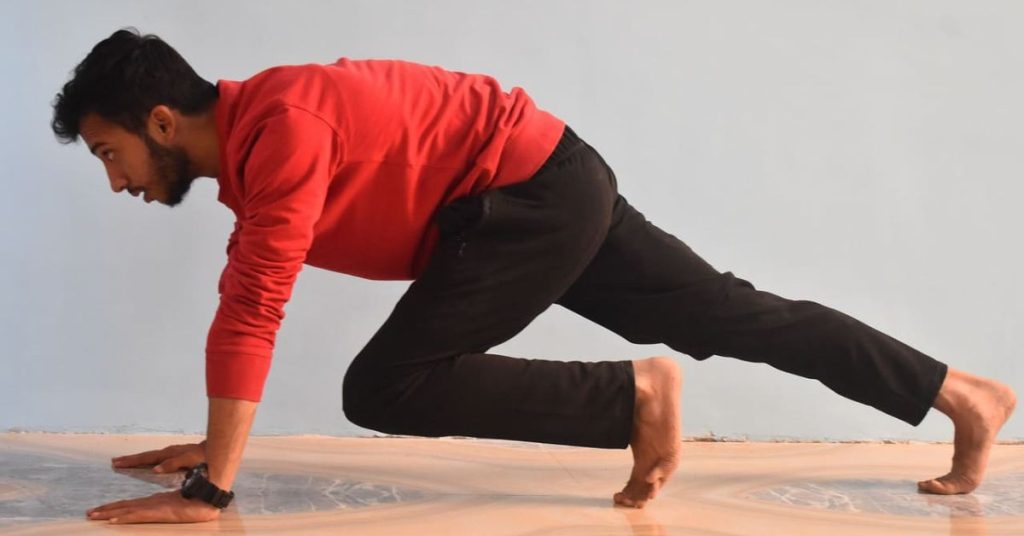
Regular physical activity is essential for maintaining a healthy body and mind.
Engaging in trampoline jumping during winter can serve as a fantastic form of exercise with various benefits, such as:
a. Cardiovascular Health:
Jumping on a trampoline is a dynamic activity that gets your heart pumping and increases your heart rate. This aerobic exercise helps improve cardiovascular health by strengthening the heart, increasing blood circulation, and enhancing overall endurance.
b. Full-Body Workout:
Trampoline jumping engages multiple muscle groups simultaneously. The bouncing motion works the legs, including the quadriceps, hamstrings, and calves, while also activating the core muscles, including the abdominals and back.
Additionally, the arms and shoulders maintain balance and coordination during jumps.
c. Improved Balance and Coordination:
Jumping on a trampoline requires coordination and balance to maintain stability while bouncing. Regular trampoline use can improve these skills, enhancing proprioception (awareness of body position) and overall balance, which can benefit various physical activities and daily tasks.
d. Bone Strength and Density:
Jumping on a trampoline’s repetitive impact and stress help promote bone strength and density. Weight-bearing exercises like trampolining can be particularly beneficial for children and older adults, as they support healthy bone development and reduce the risk of osteoporosis.
The Importance of Staying Active During Winter Months:
The winter season often reduces physical activity levels due to colder temperatures and limited outdoor opportunities. However, it is crucial to stay active even during these months.
Trampoline jumping offers an indoor activity that allows individuals to remain active while avoiding the harsh winter weather. Benefits of staying active during winter include:
Enhanced Mood and Mental Well-being:
Regular physical activity, including trampoline jumping, has been shown to release endorphins, also known as “feel-good” hormones. These hormones promote a positive mood, reduce stress, and alleviate symptoms of depression and anxiety.
Physical activity during winter can combat the winter blues and boost overall mental well-being.
Weight Management:
The winter season often brings holiday festivities and an increase in calorie-rich foods. Incorporating trampoline jumping into your routine can help burn calories and maintain a healthy weight.
Jumping on a trampoline can be an effective calorie-burning activity, helping offset any excess calorie intake during winter.
Boosted Immune System:
Regular physical activity has been linked to a strengthened immune system. Staying active during winter can help prevent illness by supporting the body’s natural defense mechanisms.
Trampoline jumping stimulates lymphatic circulation, which aids in the removal of toxins and boosts immune function.
Fresh Air and Outdoor Experience:
While trampolining can be enjoyed indoors during winter, there are still opportunities to take advantage of the crisp air and outdoor experience. Some benefits of spending time outdoors and enjoying the winter scenery while using a trampoline include:
Vitamin D Synthesis:
Spending time outdoors exposes the body to sunlight, which is essential for producing vitamin D. Vitamin D is crucial for bone health, immune function, and overall well-being.
Even during winter, when sunlight may be limited, being outside for a short period while trampolining can contribute to the body’s vitamin D synthesis.
Connection with Nature:
Being outdoors and experiencing nature has a positive impact on mental well-being. With its snow-covered landscapes and crisp air, the winter scenery can provide a refreshing and calming atmosphere.
Trampoline jumping allows you to enjoy these natural elements while engaging in a fun and active experience.
Family and Social Interaction:
Trampolining in winter can be a great opportunity for family and social interaction. Gather your loved ones and enjoy a group trampoline session outdoors. It allows you to bond, engage in friendly competitions, and create lasting memories together.
The shared experience of jumping on a trampoline in the winter can strengthen relationships and promote a sense of togetherness.
Stress Reduction:
Spending time outdoors has been shown to reduce stress levels and improve overall well-being. Combining physical activity and exposure to nature can help alleviate stress and promote relaxation. Trampoline jumping provides a fun and invigorating way to unwind and relieve daily pressures.
Increased Energy and Vitality:
Being active outdoors during winter can provide an energy boost and increase vitality. The combination of fresh air, exercise, and the invigorating experience of jumping on a trampoline can leave you feeling rejuvenated and more energized. It can help combat feelings of sluggishness often associated with the winter season.
Cognitive Benefits:
Physical activity, including trampoline jumping, has enhanced cognitive function and improved mental clarity. Engaging in regular exercise during winter can help improve focus, concentration, and overall brain health. It can also enhance productivity and creativity, benefiting both work and personal life.
Appreciation of Seasonal Changes:
Jumping on a trampoline in winter allows you to fully embrace the unique aspects of the season. You can experience the crispness of the air, witness the beauty of snow-covered surroundings, and enjoy the tranquility of a winter landscape.
It provides an opportunity to connect with the natural world and appreciate the seasonal changes that occur during winter.
Precautions and Safety Measures for Jumping on a Trampoline in Winter
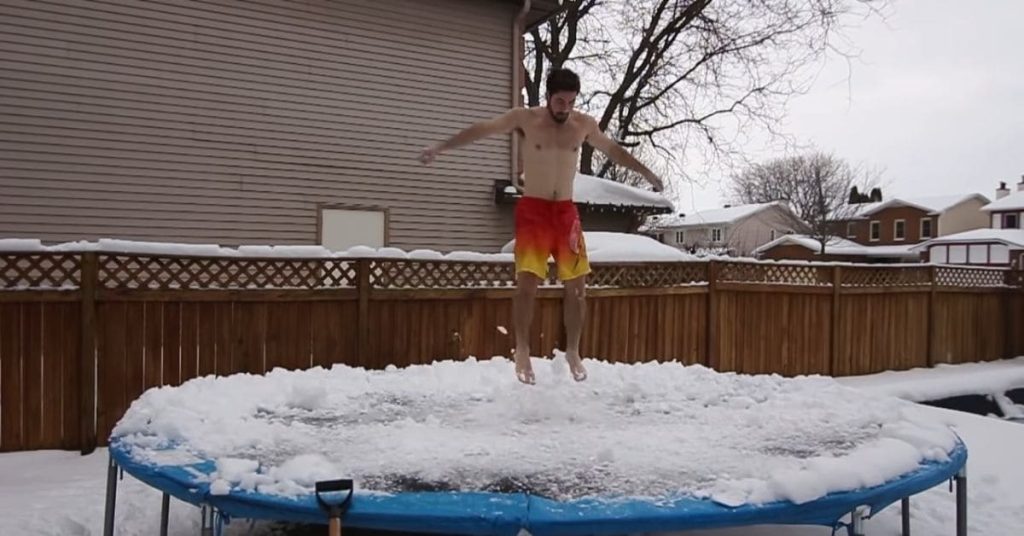
Jumping on a trampoline during the winter season can be a thrilling and enjoyable activity. However, it’s essential to prioritize safety to prevent accidents and injuries.
You can ensure a safe and enjoyable trampoline experience by following some precautions and safety measures.
We will discuss the key precautions and safety measures to consider when jumping on a trampoline in winter.
Inspecting the Trampoline:
Before using the trampoline in winter, it’s crucial to conduct a thorough inspection to ensure its safety and functionality. Check for the following:
Damage or Wear: Examine the trampoline for any signs of damage, such as bent or broken frames, springs, or torn matting. Pay attention to worn-out or frayed parts that may compromise the trampoline’s integrity. Repair or replace any damaged components before using it.
Secure Fastenings: Ensure that all components, including springs, safety pads, and netting, are securely fastened. Loose or missing parts can pose a safety risk during trampoline use. Tighten any loose screws or fasteners and replace any missing parts.
Clearing the Area:
Creating a safe and clear space around the trampoline is crucial for minimizing the risk of accidents. Take the following steps:
Remove Snow and Ice: Clear the trampoline surface of snow, ice, or other winter debris. Accumulated snow or ice can make the mat slippery and increase the risk of falls and injuries. Use a broom or shovel to clear the trampoline surface before each use.
Clear Surrounding Obstacles: Ensure that the area around the trampoline is free from any potential hazards or obstacles. Remove any branches, rocks, or other objects that may pose a risk during jumping. Keep a safe distance from trees, fences, or other structures to prevent collisions.
Proper Attire and Footwear:
Dressing appropriately for the weather and wearing suitable footwear can significantly contribute to your safety while jumping on a trampoline in winter. Consider the following:
Warm Clothing: Dress in layers to stay warm in colder temperatures. Wear thermal or moisture-wicking clothing as a base layer, followed by insulating layers such as sweaters or fleeces. Make sure to cover exposed areas, such as hands, feet, and head, with gloves, socks, and a hat.
Non-Slip Footwear: Choose footwear with non-slip soles to minimize the risk of slipping or losing traction on the trampoline mat. Avoid wearing shoes with heels, as they can affect balance and stability. Opt for athletic shoes or boots with good grip and ankle support.
Supervision and Guidelines:
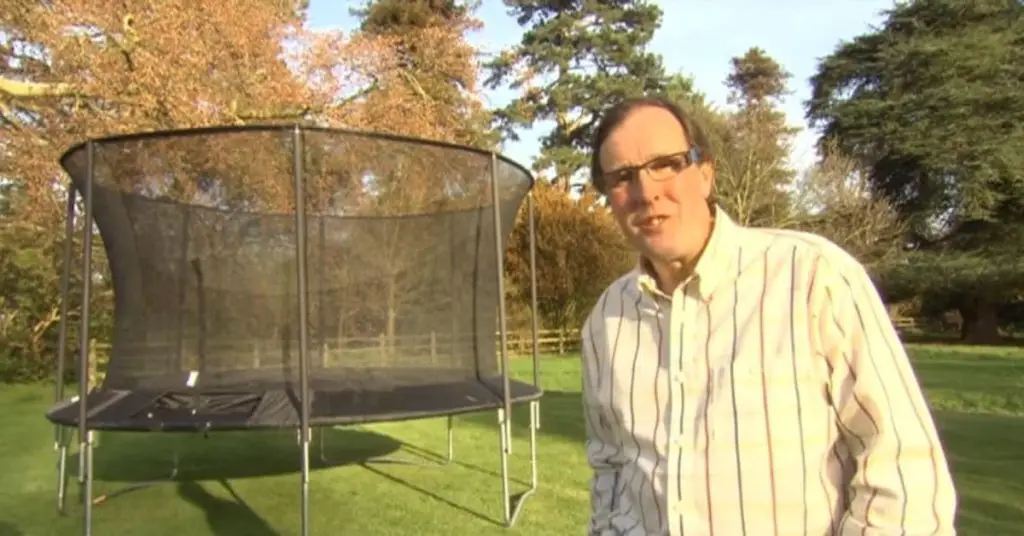
It’s essential to have proper supervision and follow safety guidelines when using a trampoline in winter. Consider the following:
Adult Supervision: Ensure that a responsible adult is present to supervise trampoline activities, especially when children are involved. They should be knowledgeable about trampoline safety guidelines and be able to provide assistance or guidance when needed.
Weight and Capacity: Adhere to the weight and capacity limits specified by the trampoline manufacturer. Overloading the trampoline can compromise its structural integrity and increase the risk of accidents.
Jumping Guidelines: Follow proper jumping techniques and guidelines, such as jumping in the center of the mat, avoiding somersaults or flips unless trained, and not attempting dangerous stunts or maneuvers.
One Jumper at a Time: To reduce the risk of collisions and injuries, allow only one person to jump on the trampoline at a time. Multiple jumpers increase the likelihood of accidents, especially when different age groups or skill levels are involved.
Safety Net and Pads: Ensure the trampoline has a safety net and padding. Safety nets help prevent falls off the trampoline, while padding covers the springs and frame, reducing the risk of injury from impact.
Ensure the safety net is properly attached and in good condition; the padding is intact and provides sufficient coverage.
Weather Conditions:
Consider the weather conditions before using the trampoline in winter. Extreme weather conditions such as heavy snowfall, freezing rain, or strong winds can pose additional safety risks. Avoid using the trampoline during severe weather conditions to prevent accidents and damage to the equipment.
Regular Maintenance:
Regular maintenance of the trampoline is essential for its long-term safety and performance. Take the following steps:
Cleaning: Regularly clean the trampoline by removing debris, dirt, and moisture. Use a soft brush or cloth to wipe down the surface and remove any accumulated snow or ice.
Lubrication: Apply lubrication to the trampoline springs, hinges, and other moving parts as the manufacturer recommends. This helps ensure smooth movement and reduces the risk of friction-related damage.
Seasonal Storage: If you live in an area with severe winter conditions, consider disassembling and storing the trampoline indoors during winter. This protects the trampoline from harsh weather and prolongs its lifespan.
Following these precautions and safety measures can minimize the risk of accidents and injuries while jumping on a trampoline in winter. Remember to prioritize safety, stay aware of your surroundings, and always supervise children to ensure a safe and enjoyable trampoline experience.
Alternatives to Jumping on a Trampoline in Winter
While jumping on a trampoline in winter can be a fun and exhilarating activity, there may be situations where it’s not feasible or preferred. Fortunately, alternative options are available to stay active and enjoy the winter season.
we will explore alternatives to jumping on a trampoline in winter, including indoor trampoline parks or facilities and other outdoor activities suitable for the colder months.
Indoor Trampoline Parks or Facilities:

Indoor trampoline parks or facilities provide controlled environments that allow you to enjoy trampoline activities regardless of the weather conditions outside.
Here are some benefits of indoor trampoline parks:
Controlled Environment: Indoor trampoline parks offer a controlled and safe environment for jumping and performing various tricks and maneuvers. The facilities are designed to ensure the safety of participants, with padded surfaces, safety nets, and trained staff to provide supervision and guidance.
Variety of Activities: These parks often offer various activities beyond traditional trampoline jumping. You can explore features such as foam pits, obstacle courses, dodgeball courts, and basketball hoops. These activities add variety and excitement to your trampoline experience.
Social Interaction: Indoor trampoline parks are popular destinations for families, friends, and groups. They provide an opportunity to socialize, bond, and have fun together. Engaging in activities with others can enhance the overall experience and create lasting memories.
Other Winter Activities
If jumping on a trampoline is not an option or you’re looking for alternative outdoor activities during the winter season, consider the following options:
Ice Skating: Ice skating is a classic winter activity that combines fun and physical fitness. Find an ice rink near you and lace up your skates for an enjoyable experience. Ice skating improves balance, coordination, and leg strength while allowing you to embrace the winter season.
Sledding: Grab a sled and head to a nearby hill or slope for a thrilling sledding adventure. Sledding provides an excellent cardiovascular workout as you climb up the hill and an adrenaline rush as you slide down. It’s a fantastic activity for families and friends to enjoy together.
Cross-Country Skiing: Cross-country skiing is a great way to explore snowy landscapes and fully work out. It improves cardiovascular endurance, strengthens muscles, and enhances balance and coordination. Find local trails or ski centers that offer cross-country skiing rentals and lessons.
Snowshoeing: Snowshoeing is a low-impact activity that allows you to traverse snowy terrains. It is suitable for all fitness levels and provides an opportunity to enjoy the tranquility of winter nature. Snowshoeing helps improve cardiovascular fitness and leg strength while immersing you in the winter scenery.
Winter Hiking: Put on your warm layers and embark on a winter hike. Many hiking trails remain accessible during the winter, offering breathtaking views and peaceful surroundings. Ensure you have appropriate footwear and use traction devices like crampons or microspikes for added stability on icy surfaces.
Indoor Exercise Classes: If outdoor activities are not your preference, consider indoor exercise classes or facilities. Yoga, Pilates, aerobics, or indoor swimming can provide a great workout and help you stay active during winter. Look for local gyms, community centers, or fitness studios that offer these classes.
Remember to dress appropriately for outdoor activities, wear layers to regulate body temperature, and protect yourself from cold weather conditions. Stay hydrated, stretch properly, and follow safety guidelines specific to each activity.
Can you leave a trampoline out in the rain?
While trampolines are designed to withstand outdoor conditions, leaving a trampoline out in the rain is generally not recommended for extended periods. Prolonged exposure to rain can cause rust, corrosion, and damage to the trampoline’s components, compromising its structural integrity and safety.
Using a weatherproof cover or storing the trampoline indoors during rainy periods is advisable to protect it from moisture.
Trampoline winter cover
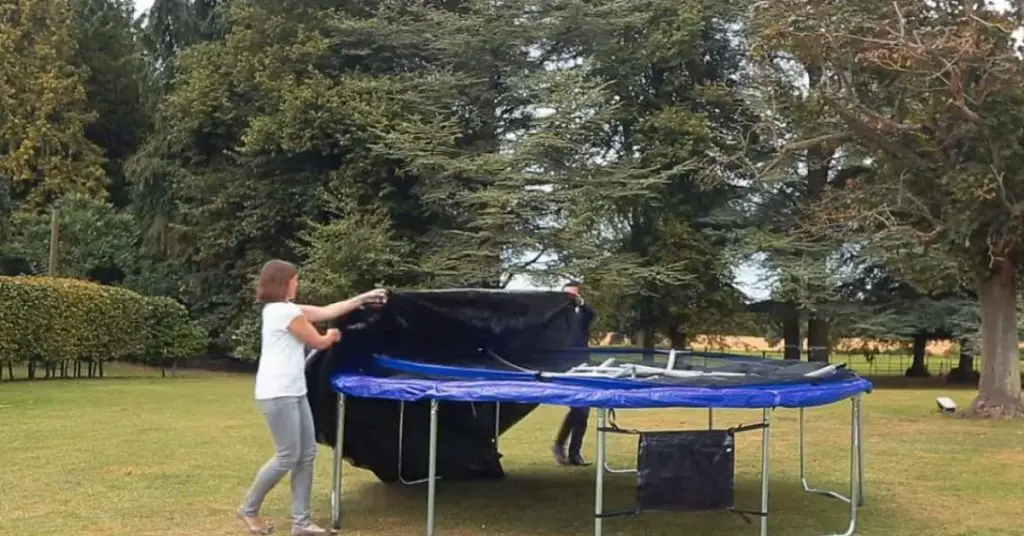
A trampoline winter cover is a specially designed protective covering that is used to shield a trampoline during the winter season.
It is typically made from durable, weather-resistant material that can withstand the elements. The purpose of a trampoline winter cover is to provide added protection against snow, ice, rain, and debris.
By securely covering the trampoline with a winter cover, you can prevent snow accumulation on the mat, protect the springs and frame from rust and corrosion caused by moisture, and keep leaves, branches, and other debris from collecting on the surface.
This helps to maintain the trampoline’s condition and prolong its lifespan.
Trampoline winter covers are usually designed with a secure attachment system, such as elastic cords or hooks, to ensure a snug fit. This prevents the cover from being blown away by strong winds or shifting during inclement weather.
Using a trampoline winter cover offers several benefits, including reducing the need for frequent cleaning, minimizing the risk of damage to the trampoline’s components, and providing added convenience when the trampoline is not in use during the winter months.
When selecting a trampoline winter cover, it’s important to choose the appropriate size that matches your trampoline’s dimensions. Additionally, following the manufacturer’s instructions for installation and maintenance is recommended to ensure the cover is properly secured and well-maintained.
Overall, a trampoline winter cover is an effective solution for protecting your trampoline from winter weather conditions, helping to preserve its quality and allowing for a longer-lasting and safer trampoline experience.
Turn the trampoline upside down in winter.
Turning a trampoline upside down during the winter season is not a recommended practice. While it may seem like a way to protect the trampoline from snow accumulation, this action can lead to additional issues and potential damage. Here are a few reasons why it is not advisable:
Structural Integrity: Trampolines are designed to be used in an upright position. Inverting the trampoline can put stress on the frame and other components that may not be designed to bear weight in that manner. This could lead to structural damage or even the possibility of the trampoline collapsing.
Stability and Safety: An inverted trampoline can become unstable, especially in windy conditions. The design of trampolines is meant to provide stability when used correctly, with the weight distributed evenly across the frame and legs. Inverting the trampoline compromises this stability and increases the risk of accidents or the trampoline being blown away.
Moisture Accumulation: While the intent behind turning the trampoline upside down may be to prevent snow accumulation, it can trap moisture between the trampoline and the ground. This can lead to the growth of mold, mildew, or rot, causing damage to the trampoline’s materials and potentially compromising its longevity.
Instead of turning the trampoline upside down, consider alternative protective measures, such as using a trampoline winter cover specifically designed for weather protection.
A winter cover helps shield the trampoline from snow, ice, and debris while allowing proper airflow to prevent moisture buildup.
If you live in an area with harsh winter conditions, you may also consider disassembling the trampoline and storing it indoors for the winter. This ensures optimal protection from the elements and extends the trampoline’s lifespan.
Remember to consult the manufacturer’s guidelines for specific winter care and storage recommendations for your particular trampoline model.
How to take down a trampoline for winter
Taking down a trampoline for winter involves several steps to ensure its proper storage and protection. Here is a general guide on how to safely dismantle and store a trampoline during the winter months:
Gather the necessary tools: Before starting the disassembly process, gather the required tools, which typically include a socket wrench or adjustable wrench and possibly a screwdriver.
Remove the safety enclosure (if applicable): If your trampoline has a safety enclosure, remove it first. Follow the manufacturer’s instructions on detaching the netting from the poles or frame. Carefully disassemble and pack away the enclosure components for storage.
Disassemble the frame: Remove the springs connecting the mat to the frame. You may need to use a socket wrench or adjustable wrench to loosen the nuts or bolts holding the springs in place. Work your way around the trampoline, removing each spring until the mat is completely detached from the frame.
Take apart the frame and legs: Once the mat is removed, dismantle the frame by removing the frame sections and separating the legs. Depending on the design of your trampoline, you may need to unscrew or unbolt the frame pieces. Take care when disassembling, and ensure you keep track of all the frame components.
Clean and dry the trampoline parts: Before storing the trampoline, clean the frame, mat, springs, and any other components. Remove any dirt, debris, or moisture from the surfaces. Allow the parts to thoroughly dry to prevent mold or mildew growth during storage.
Choose an appropriate storage location: Select a suitable storage area that is dry, sheltered, and preferably indoors. If indoor storage is not possible, consider using a weatherproof storage shed or covering the trampoline with a trampoline winter cover designed to protect it from the elements.
Store the trampoline parts: Carefully store them in the chosen location once the trampoline parts are clean and dry. If possible, keep the components organized and labeled for easier reassembly when the winter season is over.
Follow manufacturer’s guidelines: It’s essential to follow any specific instructions or recommendations the trampoline manufacturer provides regarding winter storage and reassembly.
Remember, each trampoline model may have slightly different disassembly and storage instructions, so always consult the manufacturer’s guidelines for your particular trampoline.
Properly disassembling and storing the trampoline for winter will help protect it from harsh weather conditions, extend its lifespan, and ensure a safe and enjoyable experience when it is reassembled.
How much snow can a trampoline hold?
The amount of snow that a trampoline can safely hold depends on various factors, including the design, quality, and condition of the trampoline and the type and density of the snow.
Generally, allowing snow to accumulate on a trampoline for an extended period is not recommended as it can pose risks to the trampoline’s structural integrity and safety.
Most trampolines are not designed to support heavy snow loads, and allowing excessive snow to accumulate can cause damage to the frame, springs, mat, and other components.
The weight of the snow can lead to bending or warping of the frame, stretching or breaking of the springs, and potential damage to the mat. In severe cases, the trampoline could collapse under the weight of the snow.
As a general guideline, removing snow from the trampoline as soon as possible is advisable to prevent excessive buildup. Use a soft bristle broom or a snow rake with a long handle to gently brush off the snow from the mat and frame.
Do not apply excessive force or use sharp objects that could cause damage.
If you live in an area with heavy snowfall or anticipate significant snow accumulation, it may be best to disassemble the trampoline and store it indoors for winter. This provides optimal protection and helps prevent any potential snow-related damage.
Always refer to the manufacturer’s guidelines and recommendations specific to your trampoline model for the maximum weight capacity and instructions regarding snow removal or winter care.
Can you jump on a trampoline with shoes?
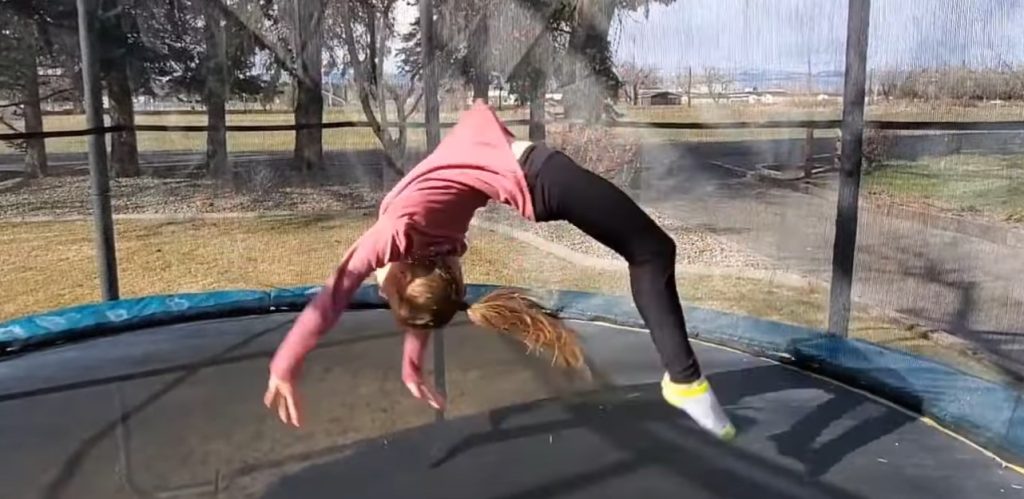
Yes, you can jump on a trampoline with shoes, but it is generally recommended to jump barefoot or with specialized trampoline socks for several reasons:
Safety: Jumping on a trampoline with shoes increases the risk of injury. Shoes with hard soles or grips can affect your balance and stability, potentially leading to slips or twisted ankles.
Additionally, the shoes’ traction may cause increased friction on the trampoline mat, increasing the risk of strain on your joints and muscles.
Trampoline Mat Protection: Wearing shoes on a trampoline can cause more wear and tear on the mat than jumping barefoot. Shoes with hard or sharp soles can potentially damage the trampoline mat, leading to premature wear, tears, or punctures.
Better Grip and Control: Jumping barefoot or with trampoline socks allows for better grip and control on the trampoline surface. This enhances your ability to perform various movements, flips, and tricks while reducing slipping risks.
Hygiene: Jumping on a trampoline with shoes can introduce dirt, debris, or foreign objects onto the trampoline surface, which can be unhygienic and potentially cause discomfort.
If you prefer to wear shoes while jumping on a trampoline, consider using specialized trampoline shoes or socks specifically designed for trampoline use. These typically have non-slip soles and provide better traction while minimizing the impact on the trampoline mat.
Ultimately, the choice of whether to wear shoes or go barefoot on a trampoline depends on personal preference and the specific guidelines set by the trampoline manufacturer.
FAQs
Q.1 Can I jump on a trampoline during the winter months?
Yes, you can jump on a trampoline in winter, but it’s important to take certain precautions and considerations to ensure safety and preserve the trampoline’s condition.
Q.2 What safety measures should I take when jumping on a trampoline in winter?
Inspect the trampoline for any signs of damage or wear, clear the area around the trampoline from snow and ice, and wear appropriate attire and non-slip footwear to minimize the risk of slips and falls.
Q.3 Will the cold temperatures affect the trampoline’s structure and materials?
Cold temperatures can potentially affect the trampoline’s structure and materials. It’s important to check the manufacturer’s guidelines to ensure the trampoline is suitable for winter use and to take additional precautions, such as using a trampoline winter cover.
Q.4 Can the trampoline handle heavy snow loads?
Trampolines are typically not designed to support heavy snow loads. Removing snow from the trampoline as soon as possible is advisable to prevent damage and potential collapse.
If you anticipate significant snowfall, consider disassembling and storing the trampoline indoors for the winter.
Q.5 Are there any benefits to jumping on a trampoline in winter?
Jumping on a trampoline in winter can provide a fun and effective workout, allowing you to stay physically active during the colder months. It also offers an opportunity to enjoy the fresh air and winter scenery while engaging in outdoor activities.
Conclusion
In conclusion, jumping on a trampoline in winter can be a fun and beneficial activity, but it requires careful consideration and safety measures. Cold temperatures can affect the trampoline’s structure and materials, potentially causing damage.
It’s important to inspect the trampoline, clear the area, wear proper attire and footwear, and follow supervision and guidelines.
Regular maintenance is crucial for the trampoline’s longevity. If jumping on a trampoline in winter isn’t feasible, alternatives such as indoor trampoline parks or other winter activities can be considered.
Leaving a trampoline out in the rain is generally not recommended, and it’s advisable to turn the trampoline upside down or take it down for winter.
The amount of snow a trampoline can hold depends on its design and strength. While jumping with shoes on a trampoline is possible, jumping barefoot or with non-slip socks is generally recommended for safety reasons.
After reading this detailed guide, we hope you now understand whether it’s safe to jump on a trampoline in winter. If you have any questions, please feel free to ask in the comments section below!

